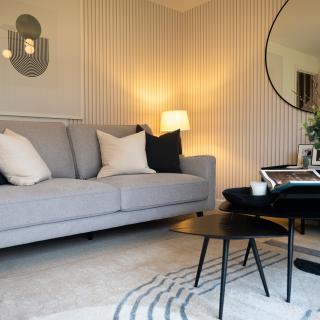As shared ownership grows in popularity and more buyers look to the scheme as a viable way of getting on the property ladder, the rules and guidelines around the initiative are pulled into focus.
One of the most common questions we hear is how much flexibility a shared ownership buyer has to improve and decorate the property they’re living in, as well as who is responsible for repairs.
Below we explore who is responsible for a shared ownership property, the rules around maintenance and answer the question ‘can you improve or decorate a shared ownership home?’
Who is responsible for repairs in a shared ownership home?
In most cases, the repairs and maintenance of a shared ownership home are the responsibility of the buyer, regardless of the share of the property they own.
This may change slightly if you’re buying an apartment under the shared ownership scheme. In this case, you’re typically responsible for the repairs of your own apartment unit, while the housing manager is responsible for any communal areas, hallways and the grounds of the property.
In the past, many housing associations offered a one-year warranty for covering defects, with a longer warranty to cover specific structural issues caused by poor construction.
Now, however, an updated shared ownership model has included the introduction of a 10-year repair warranty. This buyer-friendly option means the buyer now receives support from the housing association when dealing with essential repairs. The updated shared ownership rules apply only to new-build homes that are bought through the Affordable Homes Programme.
If the property requires structural repairs, the building warranty usually covers this cost. Just remember, if you buy a shared ownership resale property, the remaining period on the warranty transfers to you.
Can you improve a shared ownership home?
If you’re looking to make alterations or improvements to the layout or structure of your property, it’s important to first check your lease. You must have permission from the landlord or housing association before you consider making any permanent alterations to the property.
Take the time to check with your landlord to see what projects you’re able to undertake.
Also, remember that any changes you make to your property may impact the market value significantly. This can have a knock-on effect should you choose to buy more shares above 5% in the future.
For example, the cost of a new share is based on the value of your property when you want to buy the share - which is based on a valuation by a chartered surveyor.
If you make alterations to a property which impact the value of the property, that valuation has to show two different amounts:
The current market value. This is the value of the property including any price increases due to improvements.
The unimproved value. This is the value of the property without taking into account any improvements.
If you have permission from the landlord for these improvements, the price of further shares is generally based on the unimproved value.
If you don’t have permission, however, the price of the shares is typically based on the current market value, which is usually higher.
Can you decorate a shared ownership property?
You can decorate or refurbish your shared ownership property as much as you like, provided these aren’t major structural changes.
Painting a wall, installing a new kitchen or refurbishing some bathroom wall tiles, for example, falls under decoration and refurbishment.
What isn’t allowed without permission is larger alterations such as structural alterations or new flooring. These are changes that have to be authorised by the housing association or landlord.
Always check your shared ownership lease as this will break down, in detail, what you can and can’t do within your shared ownership property.
Do you want to make alterations to a shared ownership property?
If you want to make major alterations to a shared ownership property you’ve bought with us, get in touch and we can help. Contact our team on 0333 200 7304 today or email info@platformhg.com













